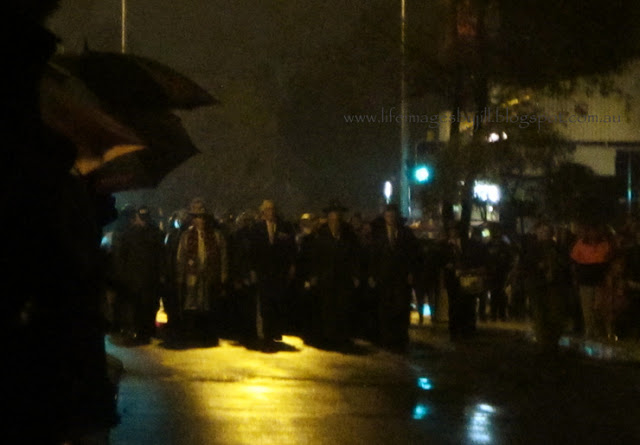The words below are from The Ode - from the poem For the Fallen, by the English poet and writer Laurence Binyo. Please click here to learn more - Traditions - the Ode
"They shall grow not old, as we that are left grow old;
Age shall not weary them, nor the years condemn.
At the going down of the sun and in the morning
We will remember them."
Age shall not weary them, nor the years condemn.
At the going down of the sun and in the morning
We will remember them."
Every year we go to the Dawn Service at our town War Memorial, and each year I have noticed the numbers attending grow. Those of us who were born in the 1950s were brought up with the stories of the World War Two years as our parents, uncles, aunts, grandparents had lived through that era. We heard about life on the home front and about their family members who served through WW2. My husband's uncle died as a prisoner of war in Burma, and my father's uncle died in the first days of the Gallipoli campaign in WW1. After going to our Australian War Memorial in Canberra a few years ago, and putting a red poppy next to their names these two young men became more real to me, and every year at the Dawn Service I shed some tears.
This morning's Anzac Day dawn service was no different. As we stood amongst the crowd in silence in the drizzling rain and watched the returned servicemen march down the street to the war memorial, listened to the speeches, songs, the single rifle shot, and the bugle playing the last post, my tears fell. This combined consciousness as we stood with bowed heads in silence as the rain fell was a powerful feeling.
Not only should we remember those that gave their lives, but also those who have returned home broken in body and spirit. Today there is a new generation of returned servicemen and women, battling their memories of what they have seen and experienced on modern day war fronts.
You can read more about this here - ABC Net- Young Diggers share their PTSD struggle
and The Bravery Trust
Today there is also a new generation of children who are learning about the Anzac tradition, through more recent conflicts like Vietnam, Afghanistan, the Middle East, and the ongoing war against terror. I think it is important that they learn about this history and the sacrifices that are made. Not to glorify it, but hopefully to learn about the futility and tragedies of war. Perhaps they will strive for a better way to solve international conflicts.
There are many books written about the war years. Recently I picked up two books about Anzac Day for children in our school library -
Anzac Biscuits by Phil Cummings, with illustrations by Owen Swan, is about a little girl who makes Anzac Biscuits to send to her father on the war front.
This is a touching story of a family torn apart by war but brought together through the powerful simplicity of Anzac biscuits as it delicately entwines the desolation of life on the frontline of war with the tenderness of life on the home front.
And
Reflection - Remembering Those Who Serve In War by Rebecka Sharpe Shelberg and illustrated by Robin Cowcher
"Left! Left! Left! Right! Left! We make our way in the dark. A family journeys through the early morning darkness... A group of young men huddle in a cold muddy trench."
This picture book is a great way to introduce children to the history of Australia and its role in various conflicts around the globe as readers connect to the story as the family attend a dawn service and Anzac Day march.
When we packed up my mother and father's house a couple of years ago, I found a tin box in my mother's bedside drawer containing letters from her brothers and a friend who served in WW2. There are letters marked "In Active Service". Letters which have a sticker to say they have been opened by the Censor, and letters marked "Privileged" which were not opened by the sensor but the writer had to sign to say that the letter only contained private and family matters. In their letters home service men and women could not talk about where they were, where they were going, or what conflicts they had been involved in.
My mother's friend who was in the RAF based in England had handwriting which was very difficult to read, so most of it is illegible to me, but I did read at the beginning of one letter that he apologised for his hand writing and saying there was no typewriter he could use. I also noted that it took at least two months for letters to be sent from England to Australia. So a four month turn around from when the sender in Australia received a return letter. In these days of instant communication can you imagine waiting for four months to receive a letter from your loved one? So much would have happened in that time. I know letters from home meant a lot to those serving overseas. These letters must have also meant a lot to my mother for her to have kept them all these years.
On Sunday we went to an open day at the South West Rail and Heritage Centre Boyanup There were various people demonstrating traditional crafts such as blacksmithing, spinning, and book binding. We saw a demonstration of Morse Code. It was fascinating to see one man transmitting messages on the Morse Code machine, and another man on the other side of the room typing the messages on a typewriter.
This method of communication was very important throughout the two world wars.
Morse code is a method for encoding text into a series of dashes and dots, that can be sent (transmitted) by means of sound, light or radio waves, and that can be decoded be a skilled listener without special equipment. The system is named after the American artist Samuel Finley Breese Morse who co-developed an electrical telegraph system at the beginning of 1836 . From: Cryptomuseum
Below you can see the Morse Code alphabet. If you look on the Cryptomuseum website, you can see how this alphabet was devised. (see second image below here). It really is amazing how people can learn and use this system at speed and very often under extreme circumstances.
Can you work out the code for SOS ?
Will you be attending an Anzac Day Service this year? Perhaps you would like to tell us about your Anzac Day in the comments.
For more information:
Australian Army - Anzac Day Tradition
Australian War Memorial
Cryptomuseum - Morse Code
Reflection - Rebecka Sharpe Shelberg
Anzac Biscuits - Phil Cummings and Phil Cummings
South West Rail and Heritage Centre, Boyanup
 Thank
you so much for stopping by. I value your comments and look forward to
hearing from you. I will try to visit your blogs in return. Have a
wonderful week.
Thank
you so much for stopping by. I value your comments and look forward to
hearing from you. I will try to visit your blogs in return. Have a
wonderful week. I am linking up to the link-ups below. Please click on the links to see fabulous contributions from around the world - virtual touring at its best!
Mosaic Monday
Life Thru the Lens
Lifestyle Fifty Monday Linkup
Our World Tuesday
Through My Lens
Image-in-ing
Wednesday Around the World at Communal Global
Worth Casing Wednesday
Travel Photo Thursday
The Weekly Postcard
You might also like:
Anzac Day 2015 - 100 years
Anzac Day goes beyond the landing in Gallipoli
Making Anzac Biscuits




































